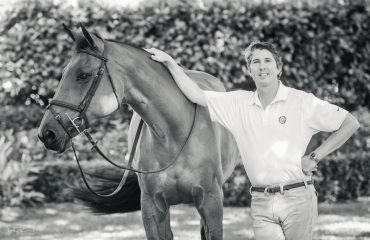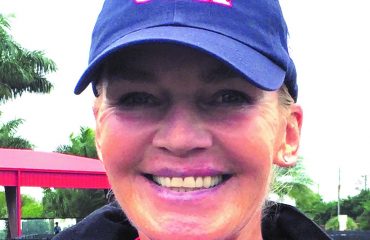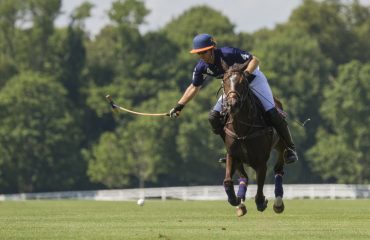
Boyd Martin riding Kyra
Well known for both his fun-loving approach to life and his indefatigable work ethic, Boyd Martin has represented the U.S.A. in three-day eventing at two Olympic Games and two World Championships, and was on the gold-medal-winning Pan Am Games team in 2015. Boyd’s wife, Silva Martin, is a grand prix dressage rider and they have two sons, Nox and Leo. Boyd and Silva train out of their own farm, Windurra USA in Cochranville, Pennsylvania, and spend winters at Stable View Farm in Aiken, South Carolina.
What makes Fair Hill such a good determining competition of a horse’s four-star readiness?
I’ve been riding at the four-star level for nearly 20 years and to be quite honest, I still feel like I’m learning all the time what it takes to be a four-star rider and what it takes for a horse to be a four-star horse. Recently 40 horses contested the Dutta Corp Fair Hill International, one of the greatest events in America. It may not have the fanciest party or trade fair or amenities of all the events in this country, but what it does have is a top-notch cross-country course, designed by Derek diGrazia, who also designs Kentucky and Bromont, and he will design the Tokyo Olympics.
Over the years I’ve walked the course and thought Derek has gone too far and made the jumps too wide or too narrow or too technical, but a couple of days later I think, Man, this guy really knows his stuff. It’s also over unbelievable terrain; good, thick, coarse; undulating hills; good, long galloping lanes; and it’s not too twisty.
I always find if I ride a horse around Fair Hill International 3*, and if the horse copes well with the course and is competitive against the clock (though not necessarily under the optimum time), he has a good chance of going to Kentucky. The challenge of this course is exactly the stepping stone you need for going to Kentucky in six months’ time. In my opinion, when you walk around Kentucky, it’s not that much bigger or tougher than Fair Hill, but it’s a bit longer in distance.
The horses that run around Fair Hill International tend to be better prepared and better conditioned when they arrive in Kentucky in April, and while I’m sure there are other events that can get you there, in my opinion, Fair Hill International is by far the best 3*course to prepare yourself and your horse for the pinnacle of the sport.
How do you decide if a horse is ready to move up a level or should stay at a level (or even drop back)?
The two horses I rode in the CCI3* at Fair Hill this year were Long Island T and Ray Price. Long Island T is a couple of years older, but they’re about the same level of experience; maybe Ludwig (Long Island T) had a little more time at the two-star level with Peter Barry before I started riding him.
Ludwig gave me an unbelievable feeling: He felt like he was strong the whole trip and sort of pricked his ears and grabbed the bit and was running to the fences; he could see them and understand them and I was just guiding him to the next obstacle. At the end of the course, he felt like there was plenty left in the engine, like he could have kept going. So now I feel like he’s ready to step up to the four-star: he’s strong and competent and I’ll likely aim him for a move-up next spring
On the other hand, Ray Price feels like he’s still developing. Funny enough, he’s much faster than Ludwig, but not as strong. He had more sprint, but had a more overwhelmed feeling, like a deer in the headlights. He was jumping all the fences just because he has a great heart and a great attitude but not because he really understood them. There were a couple of jumps where he popped in an extra step before the fence because he was surprised and trying to figure things out.
A younger version of me might kick on for a four-star just because he’s qualified, but I think this horse has a chance at the Olympics and we need to slowly build him up. I might do a couple more three-stars with him in the spring and then aim him for Bromont, another “three-and-a-half-star” course that’s also designed by Derek, before I think about moving him up to the four-star level.
I believe it’s important that at a horse’s first four-star, they’re not there to just scrape around, but to feel confident, to be able to try to make the time and jump around clear. It’s important when you consider the move up that you’re not just judging their performance on paper but the feeling you’re getting from them at the events in their competition schedule. It’s important that you don’t get this bewildered feeling from a horse you’re considering moving up at any level — it must feel as easy as a walk in the park.
What’s the emotional investment like in bringing a horse to the upper levels?
I suppose to have a horse get to the three- or four-star level, you have to spend thousands of hours and years and years developing that animal. They’re your training partner; they’re your friend and also your team member when it gets to the big competitions. It’s a unique relationship: While a jockey just sits on a horse at the race, you spend a lot of time with the horse at home, grooming and mucking out, conditioning and training. You have a strong bond, but it’s tough at the upper levels — it’s not an easy task going 500mpm in tough conditions and there are times of the year you have to push your horse. I like to think that after all the training you’ve put in at home, that 11 minutes is as easy as possible for the horse. That’s your job. If you get to the point that it feels like you’re abusing them to get the job done, you’ve really screwed up in your preparation.
Of course, doing well in a big competition is a huge feeling of satisfaction, knowing that all the hard work, riding in the snow and rain and wind and on days when it would have been nicer sitting in the warm bath at home, is all worth it. Unfortunately, you can also do the hard work, grind away, and it still doesn’t come off. To me, you have to understand that the enjoyment comes from the process, the day-to-day interaction with your horse, the journey from place to place, the camaraderie with your friends and the time at the lower levels before you get to the big glitzy events you see on TV. It’s a tough sport; that’s why there aren’t so many people at the upper levels — it’s hard to do it on one horse let alone year after year on different horses. The hardest thing is consistency: being able to do it again and again, horse after horse.













